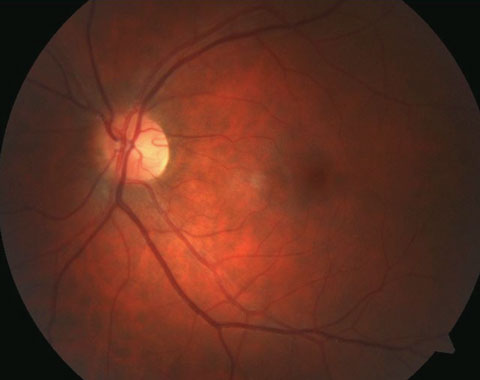 |
| The 20% of eyes with a cilioretinal artery may hold an advantage of lower AMD advancement risk. Photo: Bisant A. Labib, OD, Andrew S. Gurwood, OD, and Andrew L. Meagher, OD. Click image to enlarge. |
Much remains unknown about the pathophysiology of age-related macular degeneration (AMD) and the risk factors that cause some patients to progress from early to advanced stages. In the past, researchers have associated the condition with others such as cardiovascular disease and hypertension, which can lead to ischemia and impaired oxygen supply to the macula. They have speculated that the cilioretinal artery (CRA), present in 20% of eyes, may actually protect against choroidal neovascularization (CNV) and the advancement of AMD by improving macular blood supply and upregulating oxygen delivery.
A group of researchers recently conducted a study to determine the association between the presence of CRA and advanced AMD, including the prevalence of CNV and geographic atrophy (GA). A total of 738 patients (1,471 eyes) with AMD underwent optical coherence tomography angiography (OCT-A) as well as fundus imaging to determine the presence of CRA. On OCT-A, the researchers evaluated macular vasculature, including vessel density (VD), perfusion density (PD) and foveal avascular zone (FAZ).
The group found CRA in one eye in 27.8% of patients and unilaterally in 8.1% of patients. Those in the latter group then completed paired tests to compare AMD severity and prevalence of CNV and GA between the eye with a CRA and the fellow eye.
The results showed that overall, eyes with a CRA tend to have less severe AMD and a lower prevalence of CNV than those without (23% vs. 41.4%). Eyes with a CRA also had a better mean BCVA than that of the contralateral eyes with no CRA (0.30±0.51 vs. 0.44±0.62). A smaller central foveal thickness was found in eyes with a CRA, but it was not statistically significant.
The prevalence of GA was comparable between the groups with and without a CRA (20.7% vs. 24.1%). Macular VD, PD and FAZ were similar in both groups.
“The presence of CRA may improve macular perfusion and prevent the development of CNV,” the researchers concluded in their paper. “However, the VD, PD and FAZ parameters in the OCT-A were similar regardless of CRA presence. Future longitudinal studies are required to confirm the protective role of the CRA on macular vasculature and the development of CNV.”
Kim DI, Yoon CK, Yu HG. Unilateral cilioretinal artery and advanced age-related macular degeneration: A retrospective cross-sectional study. Am J Ophthalmol. October 30, 2021. [Epub ahead of print]. |

